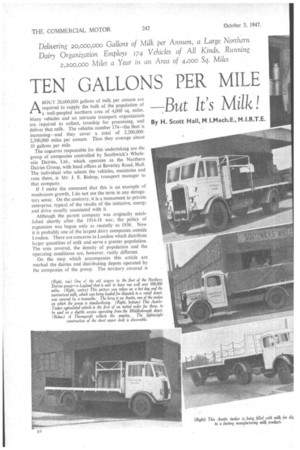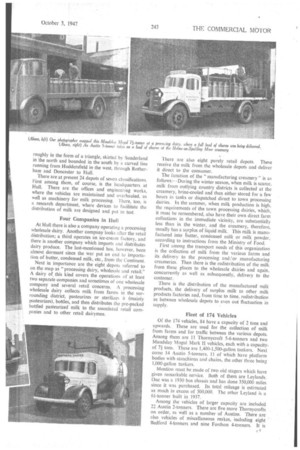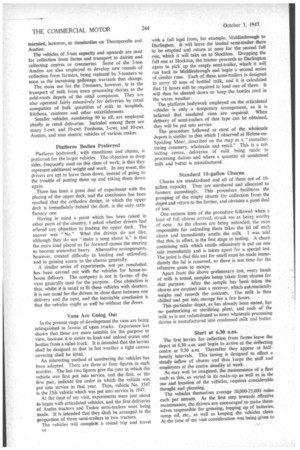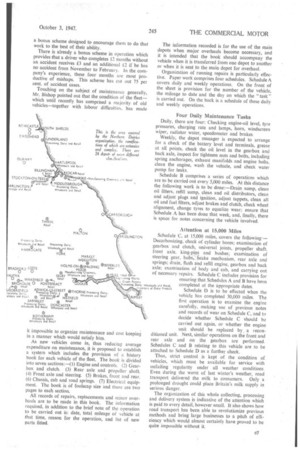TEN GALLONS PER MILE
Page 42

Page 43

Page 44

Page 45

If you've noticed an error in this article please click here to report it so we can fix it.
Delivering 20,000,000 Gallons of Milk per Annum, a Large Northern Dairy Organization Employs 174 Vehicles of All Kinds, Running 2,200,000 Miles a Year in an Area of 4,000 Sq. Miles
.But It's Milk!
By H. Scott Hall, M I.Mech.E.,
ABOUT 20,000,000 gallons of milk per annum are required to supply the bulk of the population of a well-peopled northern area of 4,000 sq. miles. Many vehicles and an intricate transport organization arc required to collect, tranship for processing, and deliver that milk. The vehicles number 174—the fleet is increasing—and they cover a total of 2,200,0002,300,000 miles per annum. Thus they average about
10 gallons per mile. ' The cogicems responsible for this undertaking are the group of companies controlled by Southwick's Wholesale Dairies, Ltd., which operates as the Northern Dairies Group, with head offices at Beverley Road, Hull. The individual who selects the vehicles, maintains and runs them, is Mr. J. E. Bishop, transport manager to 'that company.
If I make the comment that this is an example of mushroom growth, I do not use the term in any derogatory sense. On the contrary, it is a monument to private enterprise, typical of the results of the initiative, energy and drive usually associated with it.
Although the parent company was originally established shortly after. the 1914-18 war, the policy of expansion was begun only as recently as 1936. Now it is probably one of the largest dairy companies outside London. There are concerns in London which distribute larger quantities of milk and serve a greater population. The area covered, the density of population and the operating conditions are, however, vastly different.
On the map which accompanies this article are marked the dairies and distributing depots operated by the companies of the group. The territory covered is roughly in the form of a triangle, skirted by Sunderland in the north and bounded in the south by a curved line running from Huddersfield in the west, through Rotherham and Doncaster to Hull.
There are at present 24 depots of seven classifications. First among them, of course, is the headquarters at Hull. There are the offices and engineering works, where the vehicles are maintained and overhauled, as well as machinery for milk processing. There, too, is a research department, where devices to facilitate the distribution of milk are designed and put to test.
Four Companies in Hull
At Hull there is also a company operating a processing wholesale dairy. Another company looks after the retail distribution; a third operates an ice-cream factory, and there is another company which imports and distributes dairy produce. The last-mentioned has, however, been almost dormant since the war put an end to importation of butter, condensed milk, etc., from the Continent.
Next in importance are the eight depots referred to on the map as "processing dairy, wholesale and retail." A dairy of this kind covers the operations of at least two separate companies and sometimes of one wholesale company and several retail concerns. A processing wholesale dairy collects milk from farms in the surrounding district, pasteurizes or sterilizes it (mainly pasteurizes), bottles, and then distributes the pre-packed bottled pasteurized milk to the associated retail companies and to other retail dairymen. There are also eight purely retail depots. These receive the milk from the wholesale depots and deliver it direct to the consumer.
The function of the "manufacturing creamery" is as follows—During the winter season, when milk is scarce, milk from outlying country districts is collected at the creamery, brine-cooled and then either stored for a few hours in tanks or dispatched direct to town processing dairies. In the summer, when milk production is high, the requirements of the town processing dairies, which, it must be remembered, also have their own direct farm collections in the immediate vicinity, are substantially less than in the winter, and the creamery, therefore, usually has a surplus of liquid milk. This milk is manufactured into butter, condensed milk or milk powder, according to instructions from the Ministry of Food.
First among the transport needs of this organization is the collection of milk from the various farms and its delivery to the processing and /or manufacturing creameries. Then there is the redistribution of the milk from these places to the wholesale dairies and again, concurrently as well as subsequently, delivery to the customer.
There is the distribution of the manufactured milk products, the delivery of surplus milk to other milk products factories and, from time to time, redistribution as between wholesale depots to even out fluctuation in supply.
Fleet of 174 Vehicles Of the 174 vehicles, 84 have a capacity of 2 tons and upwards. These are used for the collection of milk from farms and for traffic between the various depots. Among them are 11 Thornycroft 5-6-tonners and two Maudslay Mogul Mark II vehicles, each with a capacity. of 71 tons. These are 1,400-1,500-gallon tankers. Next come 14 Austin 5-tonners, 11 of which have platform bodies with stanchions and chains, the other three being 1;000-gallon tankers.
Mention must he made of two old stagers which have given remarkable service. Both of them are Leylands. One was a 1930 bus chassis and has done 350,000 miles since it was purchased. Its total mileage is estimated as much in excess of 500,000. The other Leyland is a 61-tonner built in 1937.
Among the vehicles of larger capacity are included 22 Austin 2-tonners. There are five more Thornycrofts on order, as will as a number of Austins_ There are also vehicles of miscellaneous makes, including eight Bedford 4-tonners and nine Fordson 4-tonners. It is intended, however, to standardize on Thornycrofts and Austins.
The vehicles of 5-ton capacity and upwards are used for collection from farms and transport to dairies and collecting centres or creameries. Some of the 2-ton Austins are also employed to develop new rounds of collection from farmers, being replaced by 5-tonners so soon as the increasing gallonage warrants that change.
The main use for the 2-tonners, however, is in the transport of milk from town processing dairies to the cold-room depots of the retail companies. They are also operated fairly extensively for deliveries by retail companies of bulk quantities of milk to hospitals. kitchens, ' canteens and other establishments.
Smaller vehicles, numbering 90 in all, are employed chiefly in retail deliveries. Included among them are many 5-cwt. and l0-cwt. Fordsons, 5-cwt. and 10-cwt. Austins, and nine electric vehicles of various makes,
Platform Bodies Preferred
Platform bodywork, with stanchions and chains, is preferred for the larger vehicles. The objection to drop sides, frequently used on this class of work, is that they represent additional weight and work. In any event, the drivers are apt to leave them down, instead of going to the trouble of putting them up and taking them down again.
There has been a great deal of experiment with the placing of the upper deck, and the conclusion has been reached that the orthodox design, in which the upper deck is immediately behind the dash, is the only satisfactory one.
Having in mind a point which has been raised in other parts of the country. I asked whether drivers had offered any objection to loading the upper deck. The answer was "No." What the drivers do not like, although they do not "make a song about it," is that the extra load placed so far forward causes the steering to become somewhat heavy. Alternative arrangements, however, created difficulty in loading and unloading. and in gaining access to the churns generally.
A similar series of experiments, not yet concluded, has been carried out with the vehicles for house-tohouse delivery. The company is not in favour of the vans generally used for the purpose. One objection is that, whilst it is usual to fit these vehicles with shutters, it is not usual for the drivers to close them between one delivery and the next, and the inevitable conclusion is that the vehicles might as well be without the doors Vans Are Going Out I a the present stage of development the vans are being relinquished in favour of open trucks. Experience has shown that these are more suitable for the purpose in view, because it is easier to load and unload crates and bottles from a sided truck. It is intended that the lorries shall be designed so that in hot weather a light canvas covering shall be fitted.
' An interesting method of numbering the vehicles has been adopted. There are three or four figures in each number. The last two figures give the year in which the vehicle was first put into service, and the first, or the first pair, indicate the order in which the vehicle was put into service in that year. Thus, vehicle No. 3547 is the 35th vehicle which was put into service in 1947.
At the time of my visit, experiments were just about to begin with articulated vehicles, and the first deliveries of Austin tractors and Tasker semi-trailers were being made. It is intended that they shall be arranged in the proportion of three semi-trailers to two tractors.
The vehicles will complete a round trip and travel (6 with a full load from, for example, Middlesbrough to Darlington.. It will leave the loaded semi-trailer there to •be emptied and return at once for the second full one, which it will take on to Stockton. Dropping the full one at Stockton, the tractor proceeds to Darlington again to pick up the empty semi-trailer, which it will run back to Middlesbrough and begin a second series of similar runs. Each of these semi-trailers is designed to carry 10 tons of bottled milk, and it is calculated that l hours will be required to load one of them. It will then be sheeted down to keep the bottles cool in the warm weather.
The platform bodywork employed on the articulated vehicles is only a temporary arrangement,, as it is believed that insulated vans are required. When delivery of semi-trailers of that type can be obtained, they will be put into service.
The procedure followed at most of the wholesale depots is similar to that which I observed at Holme-onSpalding Moor, described on the map as a "manufacturing creamery, wholesale and retail." This is a collecting centre, deliveries of milk being made to processing dairies and where a quantity of condensed milk and butter is manufactured.
Standard 10-gallon Churns
Churns are standardized and all of them are of 10gallon capacity. They are numbered and allocated to farmers accordingly. This procedure facilitates the grouping of the empty churns for collection from the depot and return to the farmer, and obviates a good deal of loss.
One curious item of the procedure followed when a load of full churns arrived, struck Inc as being worthy of note. As the churns are being unloaded, the man responsible for unloading them takes the lid off each churn and immediately smells the milk. I was told that this, in effect, is the first stage in testing. A churn containing milk which smells offensively is put on one side immediately and is taken apart for a special test. The point is that this test for smell must be made immediately the lid is removed, so there is not time for the offensive gases to escape.
Apart from the above preliminary test, every batch of milk is tested, samples being taken from churns for that purpose. After the sample has been taken the churns are emptied into a receiver, which automatically weighs and records the contents. The milk is then chilled and put into storage for a few hours.
This particular depot, as has already been stated, le;s no pasteurizing or sterilizing plant, and such of the milk as is not redistributed to town wholesale processing dairies is manufactured into condensed milk and butter.
Start at 6.30 a.m.
The first lorries for collection from farms leave the depot at 6.30 a.m. and begin to arrive at the collecting centre at 9.30 a.m. Thereafter they appear at halfhourly intervals. This timing is designed to effect a steady inflow of churns and thus keeps the staff and employees at the centre steadily at work.
As may well be imagined, the maintenance of a fleet such as this, so varied in its make-up as well as in the use and location of the vehicles, requires considerable thought and planning.
The vehicles themselves average 20,000-25,000 miles each per annum. As the first step towards effective maintenance, the drivers are encouraged to make themselves responsible for greasing, topping up of batteries, sump oil, etc., as well as keeping the vehicles clean. At the time of my visit consideration was being given to a bonus scheme designed to encourage them to do that work to the best of their ability.
There is already a bonus scheme in operation which provides that a driver who completes 12 months without an accident receives £3 and an additional £2 if he has no accident from November to February, En the company's experience, these four months are most productive of mishaps. This scheme has cut out 75 per cent, of accident cases.
Touching on the subject of maintenance generally, Mr. Bishop pointed out that the condition of the fleet— which until recently, has comprised a majority of old vehicles—together with labour difficulties. has made
it impossible to organize maintenance and cost keeping in a manner which would satisfy him.
As new vehicles come in, thus reducing average expenditure on maintenance, it is proposed to establish a system which includes the provision of a history book for each vehicle of the fleet. The book is divided into seven sections:—(1) Engine and controls. (2) Gearbox and clutch. (3) Rear axle and propeller shaft. (4) Front axle and steering. (5) Brakes, front and rear. (6) Chassis, cab and road springs. (7) Electrical equipment. The book is of foolscap size and there are two pages to each section.
All records of repairs, replacements and minor overhauls are to be made in this book. The information required, in addition to the brief note of the operation to be carried out is: date, total mileage of vehicle at that time, reason for the operation, and list of new parts fitted. The information recorded is for the use of the main depots when major overhauls become necessary, and it is intended that the book should accompany the vehicle when it is transferred from one depot to another or when it is sent to the main depot for overhaul.
Organization of running repairs is particularly effective. Paper work comprises four schedules. Schedule A covers daily and weekly operations. On the front of the sheet is provision for the number of the vehicle, the mileage to date and the day on which the " task " is carried out. On the back is a schedule of these daily and weekly operations.
Four Daily Maintenance Tasks
Daily, there are four: Checking engine-oil level, tyre pressures, charging rate and lamps, horn, windscreen wiper, radiator water, speedometer and brakes Weekly, the depot manager is expected to arrange for a check of the battery level and terminals, grease at all points, check the oil level in the gearbox and back axle, inspect for tightness nuts and bolts, including spring anchorages, exhaust manifolds and engine bolts, clean the engine, wash the vehicle, and check water pump for leaks.
Schedule B comprises a series of operations which are to be carried out every 5,000 miles. At this distance the following work is to be done:—Drain sump, clean oil filters, refill sump, clean and oil distributors, clean and adjust plugs and ignition, adjust tappets, clean all oil and fuel filters, adjust brakes and clutch, check wheel alignment, change tyres to equalize wear; ensure that Schedule A has been done that week, and, finally, there is space for notes concerning the vehicle involved.
Attention at 15,000 Miles
Schedule C, at 15,000 miles, covers the following— Decarbonizing, check of cylinder bores; examination of gearbox and clutch, universal joints, propeller shaft,
steering gear, hubs,' .b.r.ake mechanism, rear axle and front axle, king:pins. and bushes; examination of
springs; drain, fah and refill engine, gearbox and back axle; examination of body and cab, and carrying out of necessary repairs. Schedule C includes provision for ensuring that Schedules A and B have been completed at the appropriate dates.
or Dairy Produce Schedule D is to be effected when the
vehicle has completed 30,000 miles. The first operation is to examine the engine carefully, making use of previous notes and records of wear on Schedule C, and to decide whether Schedule C should be carried out again, or whether the engine unit should be replaced by. a recon ditioned unit. Next, similar operations on the front and rear axle and on the gearbox are performed. Schedules C and B relating to this vehicle are to be attached to Schedule D as a further check.
Thus, strict control is kept of the condition of vehicles, which must be available for service with unfailing regularity under all weather conditions. Even during the worst of last winter's weather, road transport delivered the milk to consumers. Only a prolonged drought could place Britain's milk supply in serious danger.
The organization of this whole collecting, processing and delivery system is indicative of the attention which is paid to every detail, however small. It also shows how road transport has been able to revolutionize previous methods and bring large businesses to a pitch of efficiency which would almost certainly have proved to be quite impossible without it. c7




















































































